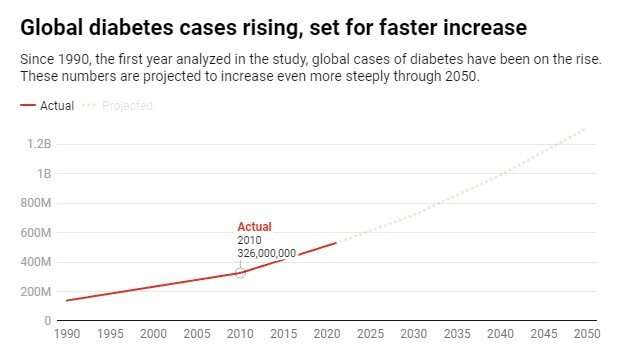This article has been reviewed according to Science X's editorial process and policies. Editors have highlighted the following attributes while ensuring the content's credibility:
fact-checked
peer-reviewed publication
trusted source
written by researcher(s)
proofread
Global diabetes cases on pace to soar to 1.3 billion people in the next 3 decades, new study finds

The number of people living with diabetes worldwide is on pace to more than double in the next three decades, for a total of 1.3 billion people by 2050. That is one of the key findings from the study on the global burden of diabetes recently published in The Lancet.
Researchers analyzed and synthesized all available epidemiological data on diabetes burden—defined as health decline due to diabetes captured through the number of cases, disease severity and deaths. The study included more than 27,000 data sources to produce estimates of diabetes prevalence, disability and deaths for 204 countries and territories from 1990 through 2021. Using a modeling tool that takes into account sociodemographic factors and obesity, we projected diabetes prevalence out to 2050.
The team also estimated the proportion of diabetes disability and death attributable to specific risk factors related to obesity, diet, physical activity, environment or occupation, tobacco use and alcohol use.
This analysis is part of the larger Global Burden of Diseases, Injuries, and Risk Factors Study, which has quantified health decline due to hundreds of diseases, injuries and risk factors since 1990. Thousands of health experts and researchers around the world both contribute to and use estimates from this study, which is continually updated.
The team projected that every country is expected to experience an increase in diabetes cases by 2050. In the regions that are expected to be hardest hit—including North Africa and the Middle East and Pacific island nations—there are countries where as many as one in five people could be living with diabetes in 2050 if current trends continue. Among older adults in these regions, diabetes prevalence is expected to be even higher.
While both type 1 and type 2 diabetes are characterized by high levels of blood sugar, also known as glucose, type 2 is a largely preventable disease that occurs because of gradual insulin resistance and is commonly diagnosed among adults. type 1, on the other hand, is an autoimmune disease where the body cannot produce insulin; it typically develops during childhood or adolescence.
The vast majority of new diabetes cases in the next three decades are projected to be type 2. We expect the two primary drivers will be aging populations and increases in obesity. In 2021, obesity was the most important risk factor for type 2 diabetes, accounting for more than half of disability and death from the disease.
Why it matters
People living with diabetes are at significantly higher risk of developing and dying from other major diseases, including ischemic heart disease and stroke, and from complications such as vision loss and foot ulcers. This compounds the stress of diabetes on health care systems, requiring more comprehensive screening and management. However, a study found that fewer than one in 10 people with diabetes in low- and middle-income countries have access to comprehensive diabetes treatment.
Based on an abundance of research, the two primary drivers of the expected rise in diabetes cases will be aging and obesity. As people age, their bodies' ability to regulate blood sugar levels changes.
In addition, studies indicate that obesity rates will continue to rise. No program has yet shown sustainable and population-level reductions in obesity.
To reverse this trend in obesity rates, an approach that targets both the behavioral and structural factors related to maintaining a healthy diet and getting enough physical activity will be needed.
What other research is being done
While this study reports on diabetes trends and risk factors over time by age, sex and geography, there are other factors that offer clues to why diabetes disproportionately afflicts certain populations.
Research shows that there are many complex social and economic dynamics at play when it comes to trying to live a healthy lifestyle. Low income, low education level and living in urban areas are all associated with a higher risk of developing type 2 diabetes. Studies also show that type 2 diabetes disproportionately affects Indigenous populations across the world, largely owing to colonization and resulting disruptions to their traditional ways of life.
The rapid increase in the number of people living with diabetes that we project in our study doesn't have to become a reality. Understanding how these trends are tied in with how people live is the first step toward changing the course of this disease over the coming decades.
More information: Kanyin Liane Ong et al, Global, regional, and national burden of diabetes from 1990 to 2021, with projections of prevalence to 2050: a systematic analysis for the Global Burden of Disease Study 2021, The Lancet (2023). DOI: 10.1016/S0140-6736(23)01301-6
This article is republished from The Conversation under a Creative Commons license. Read the original article.![]()




















